PERT Formula Examples & PERT Calculator

3-point estimation and the PERT formula are two methods that can be used to estimate the completion time of a project. This can be tricky to understand, so we have included several examples of PERT formulas below. Firstly…
The 3-point approach uses an average calculation in which values can be expressed as: “estimation = (optimistic + pessimistic + most likely) / 3“.
While the PERT formula makes it more accurate by overweighting the ‘most likely’ value by being expressed as: “estimation = (optimistic + 4 x pessimistic + most likely) / 6.”
Why Use 3-point estimation and PERT Formula?
Lengthy project timelines and unclear estimations can cause tension and frustration among team members. Nobody likes feeling like they are in the dark about how a project is progressing, especially when there is potential for something to go wrong.
Lengthy project timelines and unclear estimations can cause tension and frustration among team members. Nobody likes feeling like they are in the dark about how a project is progressing, especially when there is potential for something to go wrong. Whether you’re managing a construction project or using tools like a Construction Loan Calculator to plan your budget, accurate time estimates are critical.
Using the PERT Formula and 3-point estimation will help you understand your project timeline and accurate estimations so that everyone is on the same page. This way, you can avoid any unnecessary stress and focus on what’s important – the successful completion of your project.
PERT formula to estimate project completion time
The PERT formula is used to calculate the expected time to complete a project by taking the weighted average of the three time estimates by considering these 3 elements of time:
O = Optimistic
M = Most likely
P = Pessimistic
- The optimistic time is the shortest time to complete the project.
- The most likely time is the average time it could take to complete the project.
- The pessimistic time is the longest time it could take to complete the project.
These three elements can be expressed in the next formula:
PERT = (Optimistic + 4 x Most Likely + Pessimistic) / 6
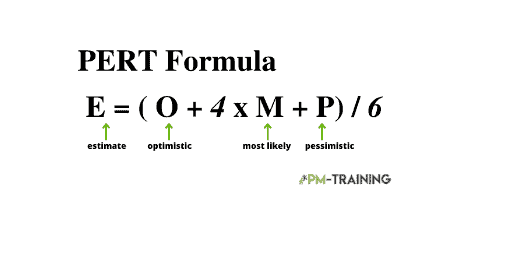
PERT Formula Example
Imagine you are the Project Manager of a software developer team recently assigned to work on an e-commerce website for XYZ Co. As the project manager, you estimate that it is most likely to develop the website in 9 weeks. Optimistically, you estimate that it can be done in 7 weeks, and pessimistically, with 11 weeks of work.
How many weeks should this project take using the PERT formula?
Let’s break it down:
Most likely: 9 weeks Optimistic: 7 weeks Pessimistic: 11 weeks
The formula is : PERT = (Optimistic + 4 x Most Likely + Pessimistic) / 6
Using the formula and data above, we can express the exercise by:
E = (7+4 * 9 + 11) / 6
Therefore, 9 weeks is the estimated amount of work time verified with the PERT formula.
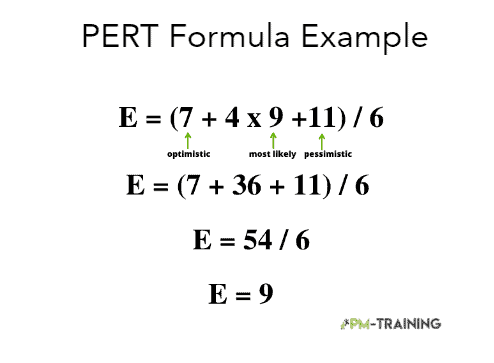
PERT Formula Calculator
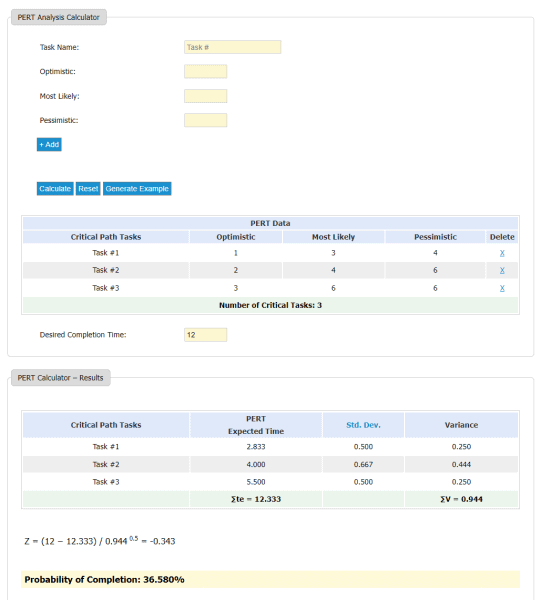
Advantages of using the PERT Formula?
There are many advantages to using the PERT formula. It can help improve the accuracy of project estimates, identify potential risks and issues early on, and better manage resources. It can also improve communication between team members and stakeholders.
This can be extremely helpful in ensuring that a project is completed on time and within budget.
How to calculate the 3-point estimation technique
3-point estimation in project management is a technique used to estimate the value of a project component when there is uncertainty about the component’s value.
Just like the PERT formula, this approach values the same considerations of project estimation: if it is optimistic, pessimistic, and most likely. However, this approach is meant to be way more collaborative, as it requires team members to come up with three values:
- Best-case
- worst-case
- most likely case
This value results in a final number, which is the estimated amount of time or cost required to achieve a project’s desired outcome.
This technique uses a formula, also known as triangular distribution, based on the historical data and information from the project team. It uses the knowledge of the people familiar with the project to generate more accurate results.
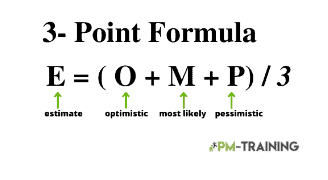
This technique uses a formula, also known as triangular distribution, based on the historical data and information from the project team. It uses the knowledge of the people familiar with the project to generate more accurate results.
3-Point Estimation Example
Imagine you are in charge of the same software developer team recently assigned to work on an e-commerce website for XYZ Co.
As the project manager, you ask your team to estimate the time it will take to complete the work using the 3-point formula.
E = ( 7 + 9 + 11) / 3
Therefore, 9 weeks is the estimated amount of time of work using the average of the 3-point estimate formula.
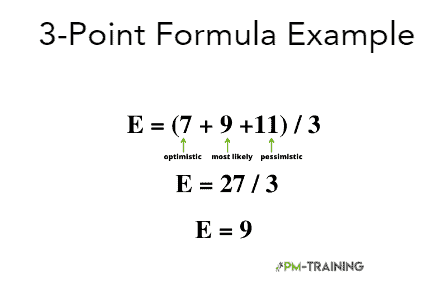
Advantages of using the 3-point estimation technique?
The three-point estimation technique has several advantages.
- First, it is a simple and easy-to-understand technique.
- Second, it is relatively accurate because it can use the team members’ expertise and provide a reasonable estimate of the value of a project.
- Third, it is flexible and can be adapted to different situations.
PERT formula vs. three point Estimation
Project estimation is one of the most challenging tasks in project management. It is also one of the most important, as the estimates provide the basis for project planning and control.
The PERT formula, derived from the beta distribution, can be used with three-point estimation to estimate a project’s duration more accurately.
Using the PERT formula, you can account for the project’s variability and develop a more granular estimate. Three-point estimation is a technique for estimating the value of a random variable. It is based on the idea that there is a normal distribution of possible values for any given event.
However, it is essential to remember that the PERT formula and three-point estimation are only estimates and that any estimate always involves some uncertainty.
Differences between 3-point estimation vs. PERT formula
| Three Point Estimation | PERT Formula |
| It uses Triangular Distribution: E = (o + m + p ) / 3 | It uses Beta Distribution (PERT): E = (o + 4m + p ) / 6 |
| It is a more estimative formula than PERT | It is more common to use along with the Critical Path Method (CPM), which helps you estimate when budget or time is tight. |
| It is commonly used to analyze an entire project’s cost, duration, or WBS. As a more collaborative estimation method with team members | It is more common to use along with the Critical Path Method (CPM), helping you to estimate when budget or time is tight. |
PERT Formula Example Video
Other Project Estimating Techniques
Various techniques can be used to estimate a project’s cost. The proper technique should be selected based on the estimated project type and the available information.
Some of the most common estimation techniques can be:
- Analogous estimating or top-down estimating
- Parametric estimating
- Bottom-up estimating
- Critical path method
Each technique has strengths and weaknesses, so selecting the proper method for the project at hand is essential.
Is the three-point estimation parametric?
There is much debate among statisticians about whether the three-point estimation method is parametric. The three-point estimation method is a statistical technique used to estimate the values of unknown parameters.
The technique is based on the assumption that the parameters follow a particular probability distribution.
Some statisticians argue that the three-point estimation method is parametric, while others say it is not. The debate is still ongoing, but there is no clear consensus.
Differences between parametric and analogous technique
Analogous and parametric estimating are two methods used to estimate the cost of a project. Analogous estimating is based on the cost of similar projects, while parametric estimating is based on the statistical relationship between variables.
PERT Formula FAQs
What is PERT used for in project management?
It will help you to identify the critical path and any potential bottlenecks in the project in a more granular estimate.
What are the disadvantages of using PERT and Three-point estimation?
It is important to remember that the PERT formula is only an estimate and that there is always some uncertainty involved in any estimate.
Why is it essential to use the 3-point estimation technique?
Using a three-point estimation technique is crucial because it helps to reduce the risk of making inaccurate estimates. This technique also helps to improve the accuracy of project planning and provides a more realistic picture of the project’s schedule and resource needs.
What are the advantages of the three-point estimation technique?
We can use the team’s expertise and the technique based on the historical data and information gathered from the project team to help create a better commitment to the team project.
What is the difference between analogous and parametric estimating?
Analogous estimating is based on the cost of similar projects, while parametric estimating is based on the statistical relationship between variables.


Hello Shane! Thanks for creating this article. It’s been helpful for my studies. However, it appears that there is a typo in the opener.
It currently says: [While the PERT formula makes it more accurate by overweighting the ‘most likely’ value by being expressed as: “estimation = (optimistic + 4 x pessimistic + most likely) / 6.”]
I believe it should be [While the PERT formula makes it more accurate by overweighting the ‘most likely’ value by being expressed as: “estimation = (optimistic + pessimistic + 4 x most likely) / 6.”]